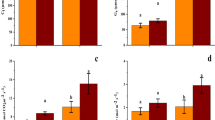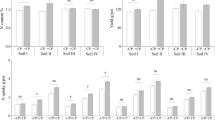Abstract
Nitrogen isotope abundance (δ 15N) of paddy rice (Oryza sativa L.) grown for 110 days after transplanting (DAT) under field conditions with ammonium sulfate (AS with −0.4‰ as a synthetic fertilizer), pig manure compost (PMC with 15.3‰ as a livestock manure compost), and hairy vetch (HV with −0.5‰ as a green manure) was investigated to test the possible use of δ 15N technique in discriminating organically grown from conventionally grown rice. At 15 DAT, the δ 15N of whole rice decreased (P < 0.05) in the order of 10.5‰ for PMC > 5.5‰ for control (without N input) > 4.0‰ for HV > 1.8‰ for AS. This difference seemed to reflect primarily the δ 15N signal of N sources. Although differences in δ 15N of rice grown with isotopically distinct N inputs (i.e. PMC vs. AS and PMC vs. HV) became smaller over time, the difference (2.8 and 3.0‰ difference at harvest on 110 DAT, respectively) was still significant (P < 0.05). However, there was no distinguishable difference between AS and HV treatment after 42 DAT. Such effect of N inputs on δ 15N of whole rice was also observed for root, shoot, and grain at harvest. Therefore, our study suggests that it is possible to distinguish rice grown with manure composts from that grown with synthetic fertilizers. However, if green manure of preceding N2-fixing plants is used as the N source, δ 15N of rice may not be a good surrogate of N sources.





Similar content being viewed by others
References
Asagi N, Ueno H (2009) Nitrogen dynamics in paddy soil applied with various 15N-labelled green manures. Plant Soil 322:251–262
Ashraf M, Mahmood T, Azam F, Qureshi RM (2004) Comparative effects of applying leguminous and non-leguminous green manures and inorganic N on biomass yield and nitrogen uptake in flooded rice (Oryza sativa L.). Biol Fertil Soils 40:147–152
Bateman AS, Kelly SD (2007) Fertilizer nitrogen isotope signatures. Isot Environ Healt Stud 43:237–247
Bateman AS, Kelly SD, Jickells TD (2005) Nitrogen isotope relationships between crops and fertilizer: implications for using nitrogen isotope analysis as an indicator of agricultural regime. J Agric Food Chem 53:5760–5765
Bateman AS, Kelly SD, Woolfe M (2007) Nitrogen isotope composition of organically and conventionally grown crops. J Agric Food Chem 55:2664–2670
Billings SA, Schaeffer SM, Zitzer S, Charlet T, Smith SD, Evans RD (2002) Alterations of nitrogen dynamics under elevated carbon dioxide in an intact Mojave Desert ecosystem: evidence from nitrogen-15 natural abundance. Oecologia 131:463–467
Bloom AJ (1988) Ammonium and nitrate as nitrogen sources for plant growth. ISI Atlas Sci 1:55–59
Bronson KF, Hussain F, Pasuquin E, Ladha JK (2000) Use of 15N-labeled soil in measuring nitrogen fertilizer recovery efficiency in transplanted rice. Soil Sci Soc Am J 64:235–239
Cassman KGS, Peng S, Olk DC, Ladha JK, Reichardt W, Doberman A, Singh U (1998) Opportunities for increased nitrogen use efficiency from improved resource management in irrigated rice systems. Field Crops Res 56:7–38
Choi WJ, Ro HM (2003) Difference in isotopic fractionation of nitrogen in water-saturated and unsaturated soils. Soil Biol Biochem 35:483–486
Choi WJ, Jin SA, Lee SM, Ro HM, Yoo SH (2001) Corn uptake and microbial immobilization of 15N-labeled urea-N in soil as affected by composted pig manure. Plant Soil 235:1–9
Choi WJ, Lee SM, Ro HM, Kim KC, Yoo SH (2002) Natural 15N abundances of maize and soil amended with urea and composted pig manure. Plant Soil 245:223–232
Choi WJ, Ro HM, Hobbie EA (2003a) Patterns of natural 15N in soils and plants from chemically and organically fertilized uplands. Soil Biol Biochem 35:1493–1500
Choi WJ, Ro HM, Lee SM (2003b) Natural 15N abundances of inorganic nitrogen in soil treated with fertilizer and compost under changing soil moisture regime. Soil Biol Biochem 35:1289–1298
Choi WJ, Arshad MA, Chang SX, Kim TH (2006) Grain 15N of crops applied with organic and chemical fertilizers in a four-year rotation. Plant Soil 284:165–174
Coats B (2003) Global rice production. In: Smith CW, Dilday RH (eds) Rice Origin, History, Technology and Production. Wiley, Hoboken, NJ, pp 247–470
Codex Committee on Food Labelling (2001) Guidelines for the Production, Processing. Marketing and Labelling of Organically Produced Foods, Rome, Italy
Diekmann KH, Datta SK, Ottow JCG (1993) Nitrogen uptake and recovery from urea and green manure in lowland rice measured by 15N and non-isotope techniques. Plant Soil 148:91–99
Evans RD (2001) Physiological mechanisms influencing plant nitrogen composition. Trends Plant Sci 6:121–126
Evans RD, Bloom AJ, Sukrapanna SS, Ehleringer JR (1996) Nitrogen isotope composition of tomato (Lycopersicon esculentum Mill. Cv. T-5) grown under ammonium or nitrate nutrition. Plant Cell Environ 19:1317–1323
Georgi M, Voerkelius S, Rossmann A, Graβmann J, Schnitzler WH (2005) Multielement isotope ratios of vegetables from integrated and organic production. Plant Soil 275:93–100
Hauck RD (1982) Nitrogen-isotope ratio analysis. In: Page AL (ed) Methods of Soil Analysis. Part 2: Chemical and Microbiological Properties. SSSA and ASA, Madison, WI
Högberg P (1997) Tansley Review no. 95. 15N natural abundance in soil-plant systems. New Phytol 137:179–203
Jenkinson DD, Fox RH, Rayner JH (1985) Interactions between fertilizer nitrogen and soil nitrogen—the so called ‘priming’ effect. J Soil Sci 36:425–444
Kano H (1995) Major essential elements. In: Matsuo T, Kimazawa K, Ishii R, Ishihara K, Hirata H (eds) Science of the Rice Plant. Food and Agriculture Policy Research Center, Tokyo, Japan, pp 310–401
Karamanos RE, Rennie DA (1981) The isotope composition of residual fertilizer nitrogen in soil columns. Soil Sci Soc Am J 45:316–321
Keeney DR, Nelson DW (1982) Nitrogen-inorganic forms. In: Page AL (ed) Methods of soil analysis. Part 2: chemical and microbiological properties. SSSA and ASA, Madison, WI
Kim YJ, Choi WJ, Lim SS, Kwak JH, Chang SX, Kim HY, Yoon KS, Ro HM (2008) Changes in nitrogen isotopic compositions during composting of cattle feedlot manure: effects of bedding material type. Bioresour Technol 99:5452–5458
Lim SS, Choi WJ, Kwak JH, Jung JW, Chang SX, Kim HY, Yoon KS, Choi SM (2007) Nitrogen and carbon isotope responses of Chinese cabbage and chrysanthemum to the application of liquid pig manure. Plant Soil 295:67–77
Lim SS, Kwak JH, Lee SI, Lee DS, Park HJ, Hao X, Choi WJ (2010) Compost type effects on nitrogen leaching from Inceptisol, Ultisol, and Andisol in a column experiment. J Soils Sediment 10:1517–1526
Magid J, Henriksen O, Thorup-Kristensen K, Mueller T (2001) Disproportionately high N-mineralization rates from green manures at low temperatures – implications for modeling and management in cool temperate agro-ecosystems. Plant Soil 228:73–82
Mann S (2003) Why organic food in Germany is a merit good. Food Policy 28:459–469
Miller JJ, Beasley BW, Chanasyk DS, Larney FJ, Olson BM (2008) Short-term nitrogen leaching potential of fresh and composted beef cattle manure applied to disturbed soil cores. Compost Sci Util 16:12–19
Monaco S, Sacco D, Borda T, Grignani C (2010) Field measurement of net nitrogen mineralization of manured soil cropped to maize. Biol Fertil Soils 46:179–184
Nakano A, Uehara Y, Yamauchi A (2003) Effect of organic and inorganic fertigation on yields, δ15N values, and δ13C values of tomato (Lycopersicon esculentum Mill. cv. Saturn). Plant Soil 255:343–349
Nendel C, Reuter S, Kubiak R, Neider R (2004) Nitrogen mineralization from mature bio-waste compost in vineyard soils. 1. Long-term laboratory incubation experiments. J Plant Nutr Soil Sci 94:159–167
Nieder R, Benbi DK, Scherer HW (2011) Fixation and defixation of ammonium in soils: a review. Biol Fertil Soils 47:1–14
Nishida M, Moriizumi M, Tsuchiya K (2005) Changes in the N recovery process from 15N-labeled swine manure compost and rice bran in direct-seeded rice by simultaneous application of cattle manure compost. Soil Sci Plant Nutr 51:577–581
Ro HM, Choi WJ (2010) Method for discriminating organic agricultural products from conventional agricultural products by using nitrogen isotope index. US Patent Publication No. US 7670842 B2.
Rogers KM (2008) Nitrogen isotopes as a screening tool to determine the growing regimen of some organic and nonorganic supermarket produce from New Zealand. J Agric Food Chem 56:4078–4083
Schmidt HL, Roβmann A, Voerkelius S, Schnitzler WH, Georgi M, Graβmann J, Zimmermann G, Winkler R (2005) Isotope characteristics of vegetables and wheat from conventional and organic production. Isot Environ Healt Stud 41:223–228
Shearer G, Kohl DH (1986) N2-fixation in field settings: estimations based on natural abundance. Aus J Plant Physiol 13:699–756
Šturm M, Kacjan-Maršić N, Jojen S (2011) Can δ15N in lettuce tissues reveal the use of synthetic nitrogen fertilizer in organic production? J Sci Food Agric 91:262–267
Thorup-Kristensen K (1994) The effect of nitrogen catch crop species on the nitrogen nutrition of succeeding crops. Fert Res 37:227–234
Yoneyama T, Kaneko A (1989) Variations in the natural abundance of 15N in nitrogenous fractions of komatsuna plants supplied with nitrate. Plant Cell Physiol 30:957–962
Yun SI, Ro HM, Choi WJ, Chang SX (2006) Interactive effects of N fertilizer source and timing of fertilization leave specific N isotopic signatures in Chinese cabbage and soil. Soil Biol Biochem 38:1682–1689
Acknowledgments
This work was supported by the Korea Research Foundation Grant funded by the Korean Government (MOEHRD; KRF-2008-313-F00005).
Author information
Authors and Affiliations
Corresponding authors
Rights and permissions
About this article
Cite this article
Yun, SI., Lim, SS., Lee, GS. et al. Natural 15N abundance of paddy rice (Oryza sativa L.) grown with synthetic fertilizer, livestock manure compost, and hairy vetch. Biol Fertil Soils 47, 607–617 (2011). https://doi.org/10.1007/s00374-011-0571-3
Received:
Revised:
Accepted:
Published:
Issue Date:
DOI: https://doi.org/10.1007/s00374-011-0571-3




